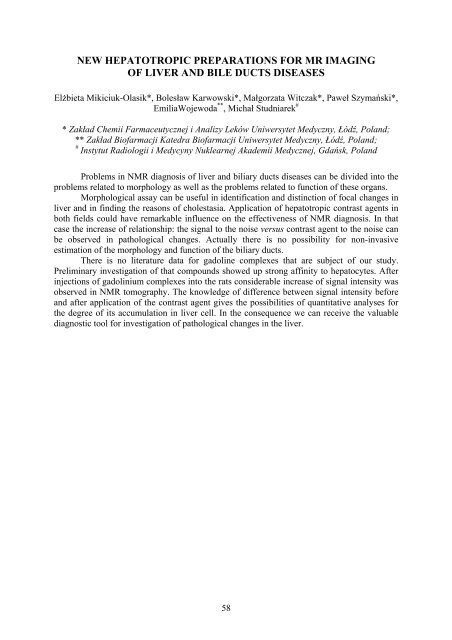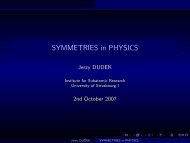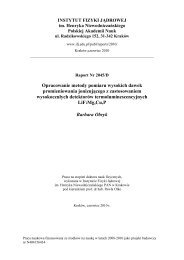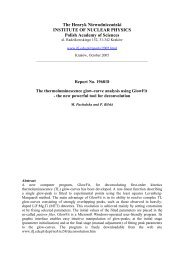Report No xxxx - Instytut Fizyki JÄ drowej PAN
Report No xxxx - Instytut Fizyki JÄ drowej PAN
Report No xxxx - Instytut Fizyki JÄ drowej PAN
Create successful ePaper yourself
Turn your PDF publications into a flip-book with our unique Google optimized e-Paper software.
NEW HEPATOTROPIC PREPARATIONS FOR MR IMAGING<br />
OF LIVER AND BILE DUCTS DISEASES<br />
Elżbieta Mikiciuk-Olasik*, Bolesław Karwowski*, Małgorzata Witczak*, Paweł Szymański*,<br />
EmiliaWojewoda ** , Michał Studniarek #<br />
* Zakład Chemii Farmaceutycznej i Analizy Leków Uniwersytet Medyczny, Łódź, Poland;<br />
** Zakład Biofarmacji Katedra Biofarmacji Uniwersytet Medyczny, Łódź, Poland;<br />
# <strong>Instytut</strong> Radiologii i Medycyny Nuklearnej Akademii Medycznej, Gdańsk, Poland<br />
Problems in NMR diagnosis of liver and biliary ducts diseases can be divided into the<br />
problems related to morphology as well as the problems related to function of these organs.<br />
Morphological assay can be useful in identification and distinction of focal changes in<br />
liver and in finding the reasons of cholestasia. Application of hepatotropic contrast agents in<br />
both fields could have remarkable influence on the effectiveness of NMR diagnosis. In that<br />
case the increase of relationship: the signal to the noise versus contrast agent to the noise can<br />
be observed in pathological changes. Actually there is no possibility for non-invasive<br />
estimation of the morphology and function of the biliary ducts.<br />
There is no literature data for gadoline complexes that are subject of our study.<br />
Preliminary investigation of that compounds showed up strong affinity to hepatocytes. After<br />
injections of gadolinium complexes into the rats considerable increase of signal intensity was<br />
observed in NMR tomography. The knowledge of difference between signal intensity before<br />
and after application of the contrast agent gives the possibilities of quantitative analyses for<br />
the degree of its accumulation in liver cell. In the consequence we can receive the valuable<br />
diagnostic tool for investigation of pathological changes in the liver.<br />
58

















